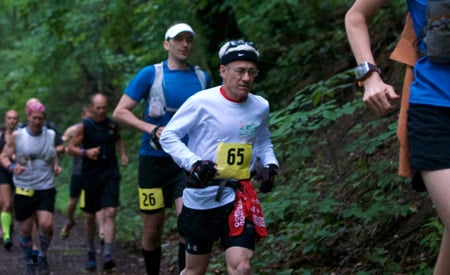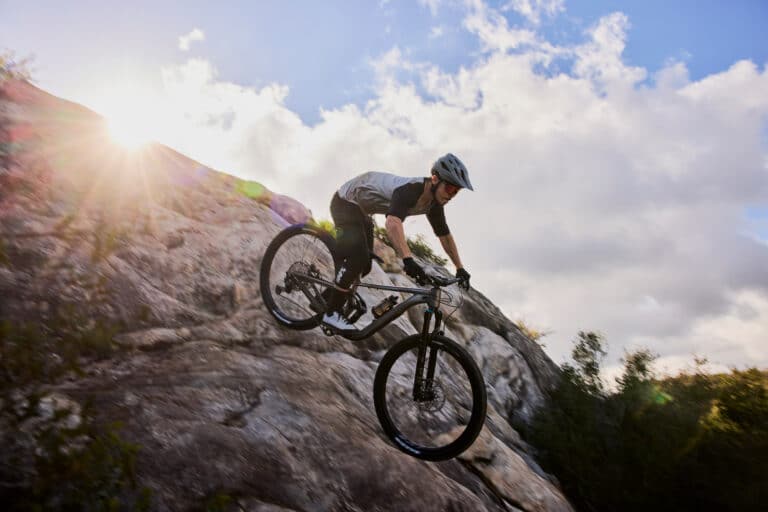At 4:30 a.m. on June 8, a crowd of bleary eyed runners gathered in a parking lot next to the Youghiogheny River in Ohiopyle, Pennsylvania. They downed last-minute cups of coffee and nibbled on bagels while synchronizing their GPS watches. In the first dim light of dawn, the race director said a prayer, started his watch, and the runners were off on an all-day slog through the woods, headlamps bobbing into the darkness.
This year was the 34th running of the Laurel Highlands Ultra Race, a grueling 70.5 mile trail run on the Laurel Highlands Hiking Trail.
“There will be bears and snakes,” Laurel Highlands Ultra Race director Tim Hewitt had told the runners at the pre-race pasta dinner. “You’ll probably fall down. And you’ll be paying so much attention to your feet that you’ll take a wrong turn and get lost.”
The Laurel Highlands trail is hard – full of rooted, rocky PA single-track with steep, gnarly climbs. In some years, nearly half the field drops out.
“The first section has a few big climbs, but I like to say the next 50 miles is downhill with a tailwind,” Hewitt said.
A few racers laughed at the under-exaggeration. Running 70.5 miles through the woods is just a morning jog for a guy like Hewitt. A vivacious 57-year-old lawyer from Latrobe, Pennsylvania, he’s finished the 1000-mile Iditarod Trail Invitational from Knik, Alaska to Nome seven times – more than anyone else, ever (one year he completed the race on a broken leg). Hewitt holds the course record of 20 days, 7 hours, and 17 minutes. In February this year, he decided the Iditarod wasn’t hard enough, so he walked to Nome totally unsupported, dragging a 100-lb. gear sled behind him. Since he didn’t even carry a tent, he had no shelter for 27 long Alaskan days. Even though Hewitt says he “kind of hit a wall at mile 700,” he still managed to set a record for the longest self-supported trek in history. His wife Loreen finished her first 350-mile Iditarod this year as well.
Ironically, when the Hewitts took over as directors for the Laurel Highlands Ultra in 2000, they added more aid stations to the course and increased the cut-off time from 18 to 22 hours. (Most runners complete the course in 19 hours.) They also added a 50-kilometer option and two team relays to accommodate more tentative trail runners. This year they had to set a limit on the number of race entries; 130 runners signed up for the 70.5 mile run.
“Ultra running used to just be for the old, slow guys like me,” Hewitt joked, “but now I think more people are realizing who much they like running on trails. Younger people and cross country teams are running trails. It’s great!” The race results show it; a team from St. Vincent College’s cross country program has swept the 70.5-mile relay race for the past three years.
Most of the runners are locals from the Allegheny and Blue Ridge Mountain area–tough, patient runners who know how to slip over slimy glacial rocks and grind up steep, technical climbs. But the Laurel Highlands Ultra also attracts runners from abroad, like seasoned Swiss ultra-runner Beat Jegerlehner.
“The Laurel Highlands Race is hard in a different way than most ultras,” said Jegerlehner, who’s competed in 34 100-mile races and a plethora of other ultra distances. “The course is totally runnable. So it’s easy to go too hard and burn out.” Did he think he had a bid for first place this year? “Definitely not,” he admitted with a grin.
This year Pennsylvanians dominated the 70.5-mile open race. Devon Olson, 25, won the men’s race in 12:05:27 and Karey Elliott, 39, was the first woman across the line at 14:55:37.
More information about the Laurel Highlands race can be found on their website, laurelultra.com.








